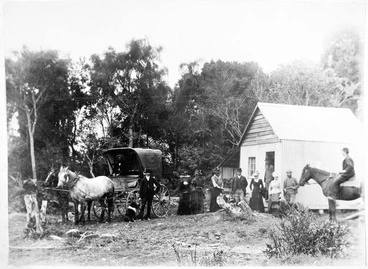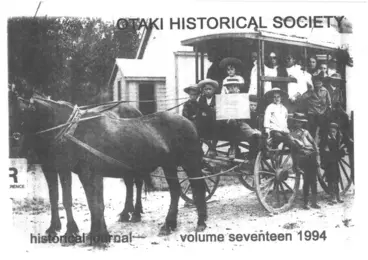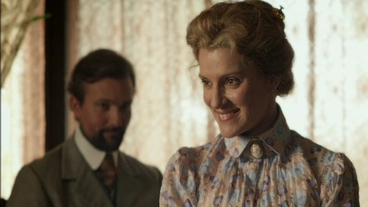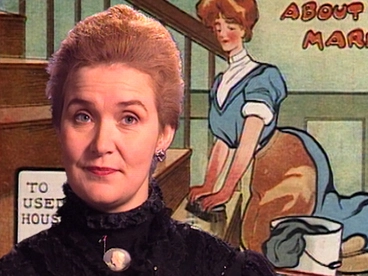Mere Ruiha Hakaraia/Mary Bevan’s signature on the 1893 Suffrage Petition
A DigitalNZ Story by National Library Services to Schools
Mere Hakaraia was one of at least six Māori women who are known to have signed the 1893 women's Suffrage Petition.
These resources and text relate to Mere Hakaraia (Ngāti Raukawa) and the wider context of Māori women who signed the 1893 Suffrage Petition. They have been sourced and collated from DigitalNZ and other websites.
View of Otaki showing St Mary's Catholic church and presbytery
Alexander Turnbull Library
Background
Mere Hakaraia was one of at least 7 Māori women who are known to have signed the 1893 Petition. When signing it she used her anglicised name.
Mere was born about 1862 at Te Ngākau (Tarukenga), north of Rotorua. Her father, Tāmati Pahika Hakaraia, and her mother, Erana Te Wainui, were both of Ngāti Raukawa. Her whānau spent considerable time on Kapiti Island cultivating land that had been given to them by Te Rauparaha. Mere and her sister became adept at preparing traditional medicines from plants.
Mere married Hakaraia Te Whena (Zacharia Bevan), who had assisted Mary Hewett when she was Māori superintendent of the Women’s Christian Temperance Union. Following the success of the 1893 petition Mere was registered on the Ōtaki and Manakau general roll for the 1893 election.
According to Tania Rei's Māori women and the vote (1993), Mary Bevan was better known as Mere Ruiha Hakaraia, but signed the (Suffrage) Petition under her anglicised name as was common practice for Māori at that time.
Source: https://nzhistory.govt.nz/suffragist/mary-bevan updated 12-Sep-2017 updated 12-Sep-2017
Dairy farm in Otaki Gorge
Alexander Turnbull Library
Women voting in 1893
Manatū Taonga, the Ministry for Culture and Heritage
Mere Ruiha Hakaraia
Kete Horowhenua
Fertile questions
Should Mary Bevan have used her Māori name to sign this petition? Why or why not?
Can we belong to more than one culture?
How is signing your name an act of power?
He ingoa Māori anō tō Mary Bevan. He aha te take i hainatia e ia te pētihana nei me tōna ingoa Pākehā?
What is your question?
Context
He Tohu Rangatira: Māori Women & the 1893 Suffrage Petition
In 1893 all across the motu – north, south, east, west and in-between – women readied themselves for agitation. Hot on the heels of the failed 1892 women’s suffrage petition, campaigners upped their game and canvassing power. Suffrage activists organised themselves to collect signatures at events, through networks and by going door to door. When the petition was presented to Parliament in June 23,969 people had supported the cause, demanding that electoral franchise be extended to women. 12 smaller petitions, now lost, were also circulating at the time. If these are taken into account the numbers could be as high as 30,000.
Of the thousands who added their tohu or signature to the petition, just 7 have been identified as Māori women.
125 years on, what do we know of the Māori signatories? They, along with thousands of others who left their mark have very little public profile, if any at all. That’s not to say they weren’t exceptional or weren’t viewed as having mana in their whānau or communities, just that their stories haven’t reached the researchers and archivists in heritage organisations.
What Really Happened - Votes for Women
NZ On Screen
Women voting, 1893
Manatū Taonga, the Ministry for Culture and Heritage
Standing in the Sunshine - Work
NZ On Screen
Other resources
He Tohu Rangatira— Māori Women & the 1893 Suffrage Petition.
Mere Hakaraia— a brief biography of Mere Hakaraia.
Small but significant contribution to women's suffrage source of pride— only 21 men signed the 1893 Women's Suffrage Petition.
Te Takanga o te Wa Maori History— guidelines for Year 1 – 8.
Writing a Biography Guide — 1893 Women’s Suffrage Petition.
Women and the vote — Women's suffrage petition online database.
Women's Suffrage Petition 1893 — New Zealand women's equality of suffrage was a world-first, but it did not come easily.
This story was compiled and curated by Te Puna Mātauranga o Aotearoa | National Library of New Zealand, Services to Schools staff, in 2019.




